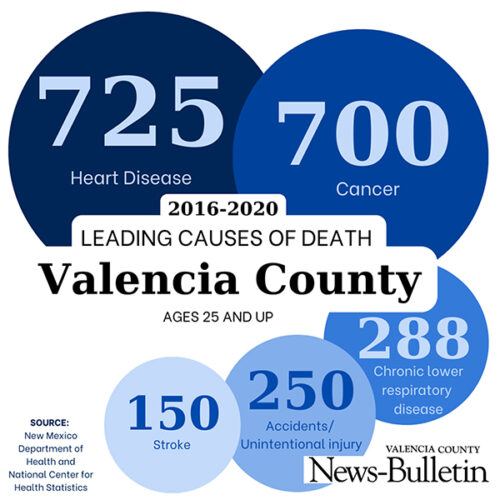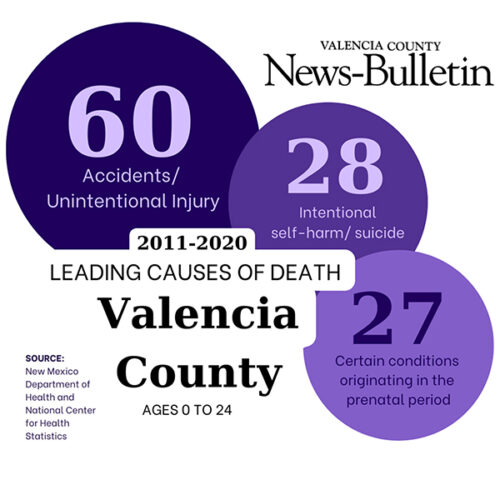Having a healthy community is a big undertaking, addressing issues from medical and dental care, mental health, food insecurity, transportation, substance misuse and addiction.
While many of those challenges can be addressed to have better health outcomes in a community, the ultimate outcome is still death.
Every three to five years, the Valencia County Community Wellness Council does a community health assessment where its board members and members of the community review leading causes of death in the county.
“We always start with what are the things in our community that are impacting us in regards to health-related issues and what are we losing our community members to at the highest rates?” said Ginny Adame, chairwoman of the Community Wellness Council’s board of directors.
While focusing on community health through the lens of cause-of-death statistics might feel morbid, Adame said in order for the council and community to know where to focus intervention and support measures, the stats have to be considered.
“We look at different causal effects. Some things are just based on age, as we get older, but if there’s unusual things that are taking our community members early, we might be able to impact things,” she said.
In doing the assessment, the health council brings the data to the community so members can see what is happening and develop ideas.
“Are there things we can rally around to make our health better?” Adame asked.
The council recently began it’s assessment with a presentation of mortality trends and contributing factors in Valencia County from Joseph O’Dell, a community health epidemiologist with the New Mexico Department of Health.
The leading cause of death in Valencia County from 2016 to 2020 in men and women age 25 and older was heart disease, O’Dell said.
The leading causes of death are a grouping of causes of deaths as defined by the National Center for Health Statistics. The second leading cause was cancer, followed by chronic lower respiratory disease, and accidents and unintentional injuries.
New Mexico is No. 3 in the nation for deaths caused by accidents/unintentional injuries, such as motor vehicle crashes, poisoning and falls. O’Dell said the theory as to why the state ranks so high is that it’s a very rural and “outdoorsy” state.
In the leading causes of death for people 0 to 24, the figures for the No. 4 and 5 causes — homicide and congenital malformations, deformations and chromosomal abnormalities — are suppressed, O’Dell said.
“It’s what’s called the ‘small number rule.’ There are so few, you could by deduction or process of elimination, easily determine the exact person,” O’dell said. “To protect their identify, those numbers are not typically shared. I can confirm those are four and five.”
He noted the No. 3 cause of death in that age range — certain conditions originating in the perinatal period — as well as the fourth leading cause are in relation to deaths occurring between 0 and 364 days.
The No. 1 leading cause of death for those under 24 years old was accidents and unintentional injuries, with intentional self-harm at No. 2.
Overall, 83 percent of all deaths in Valencia County occur after age 55, and in 2020, 32 percent of the county’s population was 55 and older.
“We have an older population in New Mexico so we often do have higher rates for certain causes of death,” O’Dell said.
Drug overdose deaths are normally captured in the categories of unintentional/accidents, suicide and homicide, he said, but when isolated, the rates remain relatively stable year over year.
The age-adjusted mortality rate per 100,000 population in Valencia County for 2016 was 29.1. The rate rose to 41.5 in 2017, dipped slightly down to 38.5 in 2018, then down to 34 in 2019 and up to 42.7 in 2020.
“There’s not a lot of fluctuating. New Mexico and Valencia County have similar rates, but they both have higher rates than the U.S. based on the 2016 to 2020 rates,” he said.
Alcohol-related deaths, both due to chronic disease and injury, are increasing over time.
“One in six adult deaths in New Mexico are attributable to alcohol. Nationally it’s one in 10,” O’Dell said. “It has been an issue for New Mexico historically and the same is true for Valencia County with a rate of 88.8 per 100,000 in 2020.”
To address issues such as alcohol and substance misuse, Adame said there needs to be a shift in the way people in the community think.
“We know alcohol is a massive, massive, massive problem but we lack the readiness to say, ‘Hey, this is killing so many New Mexicans, of our young people. It’s causing harm or death and we really should do something,’” she said during the presentation. “There’s not that attitude around alcohol and it shows. We might identify it as a problem but people in the community might not recognize it.”
Of the 39 people at the presentation, 17 of them identified various issues under the umbrella of substance misuse and addiction as the issue of most concern.
“We want to go out to different community areas and capture as many voices as we can, get as much public input as we can, in regards to priorities,” Adame said. “Once we prioritize, then we’re going to try to identify some evidence-based ways that we can impact the issues that our community identifies, come up with an actual plan. Then we’ll work that plan for the next three to five years until our next assessment. Hopefully things will swing in a direction that we want them to.”
For more information about the wellness council, visit communitywellnesscouncil.org. The CWC’s free health resources directory can be found there or at resourcesvalencianm.org.
Julia M. Dendinger began working at the VCNB in 2006. She covers Valencia County government, Belen Consolidated Schools and the village of Bosque Farms. She is a member of the Society of Professional Journalists Rio Grande chapter’s board of directors.




















